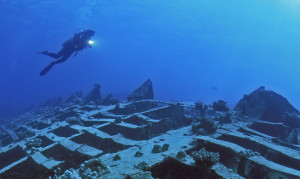Artificial reefs a benefit to divers and boaters alike.
Artificial reefs are not a new tool to manage out marine fisheries, the Japanese have been using them as a fishery tool since the late 1940’s. Back in 1972 I was able to obtain a $48,200 grant from the Florida Park Service to start the Clearwater Artificial Reef Program, and then in 1974 it became the Pinellas County Artificial Reef Program using County funds, Back then I had a USF graduate student doing a Masters Degree Thesis on the economic benefits of this reef building program. That study found the economic benefits outweighed the cost over 10 to 1.
Just a few months ago an economic study by some scientist at Florida Sea Grant found benefits from artificial reefs in the Pasco to Manatee county area were actually in the millions (that is if you can believe anything good can come out of the University of Florida).
 Studies I have done starting back in the late 1960’s and others in recent years have shown that when an artificial reef is properly sited and constructed, it can actually produce more food per acre than a natural reef! While many environmentalist find it hard to accept that man can actually improve on nature, it really is not that hard to understand. With a natural reef the coral and other marine reef building organisms are growing for their own ecological reasons, the fact that fish and other marine species find it good habitat is not important to the corals. With an artificial reef we can actually design and build a reef that has a much more fish and marine life habitat that what occurs by accident on a natural reef.
Studies I have done starting back in the late 1960’s and others in recent years have shown that when an artificial reef is properly sited and constructed, it can actually produce more food per acre than a natural reef! While many environmentalist find it hard to accept that man can actually improve on nature, it really is not that hard to understand. With a natural reef the coral and other marine reef building organisms are growing for their own ecological reasons, the fact that fish and other marine species find it good habitat is not important to the corals. With an artificial reef we can actually design and build a reef that has a much more fish and marine life habitat that what occurs by accident on a natural reef.
We can build one type of reef to attract bottom dwelling spices like grouper, snapper, sea bass, and grunts and another type of reef to attract pelagic species like mackerel, amberjack, kingfish an cobia.
Another thing to consider is that ling after there is grass growing on I-75 these artificial reefs will still be providing habitat for thousands of years (or at least until sea level again drop to ice age levels and they become dry land).
It was once thought that artificial reefs would only concentrate the existing fish populating and that if we made it “to easy” for anglers to catch more fish we would be causing overfishing. While it is true that when we construct a new artificial reef there will be lots of grouper and snapper attracted to the reef in just a few days. These fish moved from the adjacent natural reefs to the artificial reef because it offered better shelter. However studies I have done on natural reefs prior to construction of a new reef have shown that within a year often have even higher populations due to lack of fishing pressure now that all the anglers have moved to the artificial reef.
Much of the sea floor in this part of Florida is bare sand which provides little or no food or habitat for most benthic fish species. Once the artificial reef is constructed, the new hard substrate provides attachment surfaces for marine algae that could not grow on bare sand. These new marine plants now carry on photosynthesis and produce new food that will move up the marine food chain. In addition, these new surfaces will provide attachment for barnacles, sponges and a host of other “filter feeders” that take plankton out of the water column and channel it into food chains that end up in many food and game species of fish.
An additional benefit is that many of the materials we use for artificial reefs are olf ships, barges that are no longer useful on land. Old bridges rubble and used concrete culvert from road construction that would normally go to a land fill, now becomes excellent marine habitat that will last for thousands of years, a win-win for man and fish.
By Dr. Heyward Matthews, Oceanographer
